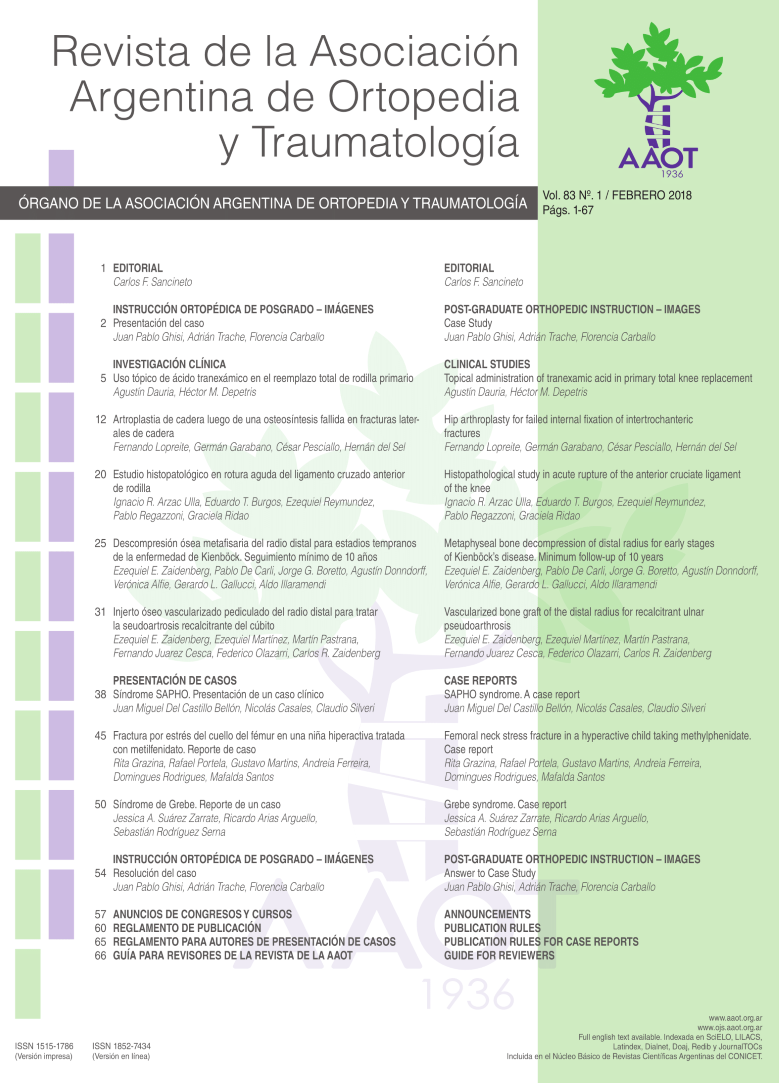Estudio histopatológico en rotura aguda del ligamento cruzado anterior de rodilla. [Histopathological study in acute rupture of the anterior cruciate ligament of the knee].
Contenido principal del artículo
Resumen
Descargas
Métricas
Detalles del artículo

Esta obra está bajo licencia internacional Creative Commons Reconocimiento-NoComercial-CompartirIgual 4.0.
La aceptación del manuscrito por parte de la revista implica la no presentación simultánea a otras revistas u órganos editoriales. La RAAOT se encuentra bajo la licencia Creative Commons 4.0. Atribución-NoComercial-CompartirIgual (http://creativecommons.org/licenses/by-nc-sa/4.0/deed.es). Se puede compartir, copiar, distribuir, alterar, transformar, generar una obra derivada, ejecutar y comunicar públicamente la obra, siempre que: a) se cite la autoría y la fuente original de su publicación (revista, editorial y URL de la obra); b) no se usen para fines comerciales; c) se mantengan los mismos términos de la licencia.
En caso de que el manuscrito sea aprobado para su próxima publicación, los autores conservan los derechos de autor y cederán a la revista los derechos de la publicación, edición, reproducción, distribución, exhibición y comunicación a nivel nacional e internacional en las diferentes bases de datos, repositorios y portales.
Se deja constancia que el referido artículo es inédito y que no está en espera de impresión en alguna otra publicación nacional o extranjera.
Por la presente, acepta/n las modificaciones que sean necesarias, sugeridas en la revisión por los pares (referato), para adaptar el trabajo al estilo y modalidad de publicación de la Revista.
Citas
2. Miyasaka KC, Daniel DM, Stone ML, Hirshman P. The incidence of knee ligament injuries in the general population. American Journal of Knee Surgery 1991;4:3-8.
3. Shino K, Oakes BW, Horibe S, Nakata K, Nakamura N. Collagen fibril populations in human anterior cruciate ligament allografts. Electron microscopic analysis. Am J Sports Med 1995 Mar-Apr;23(2):203-8; discussion 209.
4. Gao F, Zhou J, He C, Ding J, Lou Z, Xie Q, Li H, et al. A Morphologic and Quantitative Study of Mechanoreceptors in the Remnant Stump of the Human Anterior Cruciate Ligament. Arthroscopy 2016.
Feb;32(2):273-80. doi: 10.1016/j.arthro.2015.07.010. Epub 2015 Oct 1.
5. Butler DL, Guan Y, Kay MD, Cummings JF, Feder SM, Levy MS. Location-dependent variations in the material properties of the anterior cruciate ligament. J Biomech 1992 25:511–518.
6. Chandrashekar N, Mansouri H, Slauterbeck J, Hashemi J. Sex- based differences in the tensile properties of the human anterior cruciate ligament. J Biomech 2006 39:2943–2950.
7. Suzuki D, Otsubo H, Watanabe T,Kamiya T, Nagoya S, Yamashita T, Shino K. Ultrastructure of the three anterior cruciate ligament bundles. Clin Anat 2015 Oct;28(7):910-6. doi: 10.1002/ca.22586. Epub 2015 Jun 28.
8. Strocchi R, Pasquale V, Gubellini P, Facchini A, Maracci M, Buda R, Zaffagnini S, Ruggeri A. The human anterior cruciate ligament: histological and ultrastructural observations. J Anat 1992 Jun; 180(Pt 3): 515–519.
9. Oka S, Schuhmacher P, Brehmer A, Traut A, Kirsch J, Siebold R. Histological analysis of the tibial anterior cruciate ligament insertion. Knee Surg Sports Traumatol Arthrosc. 2016 Mar;24(3):747-53. doi: 10.1007/s00167-015-3924-x. Epub 2015 Dec 19.
10. Mall NA, Frank RM, Saltzman BM, Cole BJ, Bach BR. Results After Anterior Cruciate Ligament Reconstruction in Patients Older Than 40 Years: How Do They Compare With Younger Patients? A Systematic Review and Comparison With Younger Populations. Sports Health. 2016 Mar-Apr;8(2):177-81.
11. Vaishya R, Kumar Agarwal A, Ingole S, Vijay V. Current Trends in Anterior Cruciate Ligament Reconstruction: A Review. Cureus. 2015 Nov; 7(11): e378.
12. Gwinn DE, Wilckens JH, McDevitt ER, Ross G, Kao TC: The relative incidence of anterior cruciate ligament injury in men and women at the United States Naval Academy. Am J Sports Med. 2000, 28:98–102.
13. Chahla J, Arroquy D, Perez Herrera G, Orlowski B, Guiñazu J, Carboni M, Vilaseca T. Lesión del Ligamento Cruzado Anterior: ¿Es la Disminución en la Movilidad de la Cadera un Factor Predisponente? Artroscopia Vol. 21, No 4 : 121-123 | 2014
14. Uhorchak, J.M., C.R. Scoville, G.N. Williams, R.A. Arciero, P. St Pierre, D.C. Taylor, Risk factors associated with noncontact in- jury of the anterior cruciate ligament: a prospective four-year eval- uation of 859 West Point cadets. Am J Sports Med, 2003. 31(6): p. 831-842.
15. Eiling, E., A. L. Bryant, W. Petersen, A. Murphy, and E. Hohmann, Efects of menstrual-cycle hormone uctuations on musculotendinous sti fness and knee joint laxity. Knee Surg Sports Traumatol Arthrosc, 2007. 15(2): p. 126-132.
16. Iwaki, H., V. Pinskerova, and M.A. Freeman, Tibiofemoral move- ment 1: the shapes and relative movements of the femur and tibia in the unloaded cadaver knee. J Bone Joint Surg Br, 2000. 82(8): p. 1189-1195.
17. Meister, K., M.C. Talley, M.B. Horodyski, P.A. Indelicato, J.S. Hartzel, and J. Batts, Caudal slope of the tibia and its relationship to noncontact injuries to the ACL. Am J Knee Surg, 1998. 11(4): p. 217-219.
18. Vaishya R , Hasija R: Joint hypermobility and anterior cruciate ligament injury . J Orthop Surg (Hong Kong). 2013, 21:182–84.
19. Danylchuck, K.D., Finaly, J.B., Krcek J.P. Microstructural organization of human and bovine cruciate ligaments. Clinical Orthopaedics and Related Research. 1978. 131 : 294 - 298.
20. Ho Chen H, Lintner M, Luo Z. Observation of the ultrastructure of anterior cruciate ligament graft by atomic force microscopy. Scanning. 2009 Jan-Feb;31(1):19-23. doi: 10.1002/sca.20137.
21. Bayat, M; Mohammadzade, F; Rakhshan, M. Electron And Light Microscopic Study Of Anterior Cruciate Ligament Of Rabbit. J Anat. Soc. India 2003 52(2) 155-158
22. Dodds J.A. and Arnoczky, S.P. (1994) : Anatomy of the anterior cruciate ligament : a blue print for repair and reconstruction. Arthroscopy. 10(2):132- 139.
23. Simokochi Y, Shultz S. Mechanisms of noncontact anterior cruciate ligament injury. J Athl Train. 2008 Jul-Aug;43(4):396-408. doi: 10.4085/1062-6050-43.4.396.
24. Parry DA, Barnes GR, Craig AS. A comparison of the size distribution of collagen fibrils in connective tissues as a function of age and a possible relation between fibril size distribution and mechanical properties. Proc R Soc Lond B Biol Sci. 1978 Dec 18;203(1152):305-21.
25. Haus BM, Mastrangelo AN, Murray MM. Effect of ante- rior cruciate healing on the uninjured ligament insertion site. J Orthop Res 2012;30:86-94.

